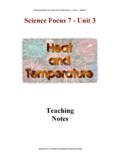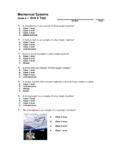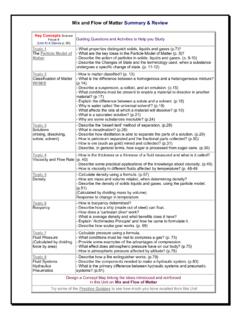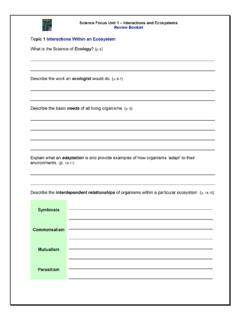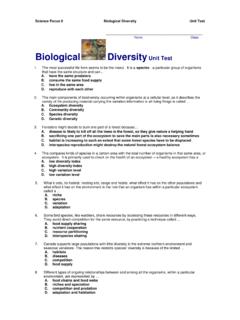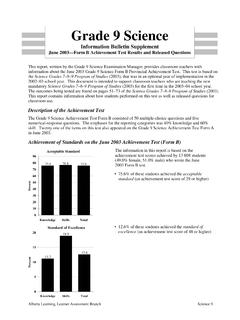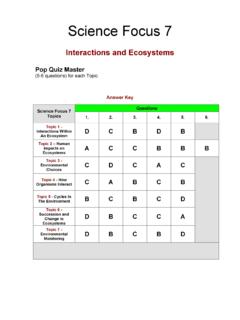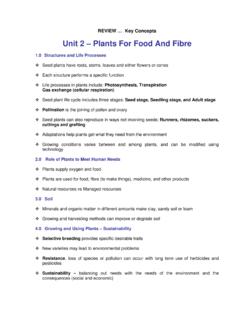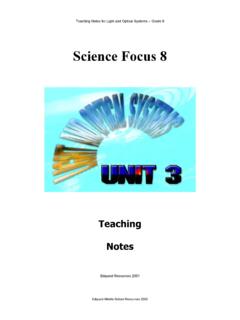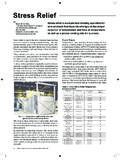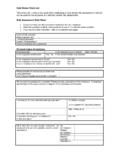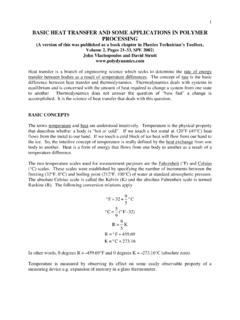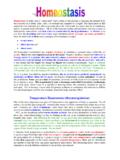Transcription of Unit 3 – Heat and Temperature - EDQUEST SCIENCE
1 REVIEW Key Concepts Unit 3 heat and Temperature technologies for Obtaining and Controlling heat heat technologies have evolved over time Culture and technology are linked Evolution has integrated heat -related materials and technologies Choices about the environment involves individuals and society heat Affects Matter Transferring heat to and from matter can cause a change in state The Particle Model of Matter explains changes in state and volume Temperature is the measure of the average kinetic energy of the particles in a substance Thermal energy is the total kinetic energy of the particles in a substance heat is transferred from an area of high kinetic energy to an area of low kinetic energy Conduction (in contact), Convection (circular motion) and Radiation (waves).
2 Natural Phenomena and Technology Devices Thermal energy is produced by the Sun, decay, fire and geothermal Passive and Active solar heating systems use the sun's energy and are environmentally friendly Thermostats control Temperature in heating systems Insulation helps block unwanted heat transfer ( heat loss). Benefits and Costs of heat technologies Non-renewable resources have a limited supply Fossil fuels are the major sources of heating, but degrade the environment Costs of using natural resources: economic, environmental and societal Energy Alternatives: solar, wind, geothermal, nuclear and hydro-electric (gravitational). technologies for Obtaining and Controlling heat heat technologies have evolved over time Before 1600, people believed heat was a combination of fire and air.
3 They thought it was an invisible fluid. What was the fluid called and explain the Theory' it was based on? _____. _____. _____. _____. Explain the Particle Theory of heat _____. _____. _____. Culture and technology are linked How is culture and heat technology linked? _____. _____. _____. Describe the difference between the units associated with heat . joule, watt, kilowatt, gigajoule _____. _____. _____. _____. What is the difference between needs and wants'? _____. _____. _____. _____. Evolution has integrated heat -related materials and technologies What activities are directly related to heat related technologies ? (eg. staying comfortable in our homes). _____. _____. _____. Complete the Heating Technology Timeline _____. 7000 100 _____. 1200 _____. 1300s _____.
4 1700s _____. late 1700s _____. 1800s _____. 1906 _____. Choices about the environment involves individuals and society What does it mean when we are asked to make sustainable choices? _____. _____. _____. heat Affects Matter Transferring heat to and from matter can cause a change in state Describe the changes that take place with the transfer of heat to and from water. _____. _____. _____. _____. The Particle Model of Matter explains changes in state and volume List the four main principles in the Particle Model of Matter _____. _____. _____. _____. Kinetic energy is the energy of movement. Describe the particles in each state of matter. Solid _____. Liquid _____. Gas _____. Complete the following Chart that helps to show the relationship between heat , the particle model and changes of state.
5 Solid Liquid Gas Space between particles Volume Shape Adding heat Removing heat Temperature is the measure of the average kinetic energy of the particles in a substance Thermal energy is the total kinetic energy of the particles in a substance heat is transferred from an area of high kinetic energy to an area of low kinetic energy Explain the difference between thermal energy, heat and Temperature in terms of kinetic energy. _____. _____. _____. _____. How is Temperature measured? _____. _____. Complete the Timeline, by adding in the dates that are missing . History Of Thermometers Date Event 200 The first thermometers were called thermoscopes. _____ Santorio Santorio was the first inventor to put a numerical scale on the instrument. Galileo Galilei invented a rudimentary water thermometer, which, for the first time, _____.
6 Allowed Temperature variations to be measured. Ole Romer created one of the first practical thermometers, using red wine as the 1701 . Temperature indicator. Daniel Gabriel Fahrenheit was the German physicist who invented the alcohol _____. thermometer. _____ Fahrenheit invented the first mercury thermometer. _____ Fahrenheit introduced the Temperature scale that bears his name - Fahrenheit Scale. _____ The 1st precise scale was developed by Anders Celsius. 1848 Lord Kelvin invented the Kelvin Scale. _____ The electrical-resistance-thermometer was invented in Germany. Sir Thomas Allbutt invented the first medical thermometer used for taking the _____. Temperature of a person. _____ Theodore Hannes Benzinger invented the ear thermometer. _____ David Phillips invented the infra-red ear thermometer.
7 1990s Dr. Jacob Fraden, invented, the Thermoscan Human Ear Thermometer. Conduction (in contact), Convection (circular motion) and Radiation (waves). What happens to the volume of different materials when heat is added? (Give two examples). _____. _____. _____. _____. _____. _____. Complete the Chart for each type of heat Transfer Conduction Convection Radiation States of matter solid liquid, gas Volume change increases ( heat added). Volume change decreases ( heat removed). Particle motion waves heat transferred by Conduction /. convection current . Insulation needs space Reflect shiny Absorb In contact Natural Phenomena and Technology Devices Thermal energy is produced naturally Illustrate and describe 4 natural sources of Thermal Energy that are available to us.
8 The Sun Forest Fires _____ _____. Geothermal Decay _____ _____. Passive and Active solar heating systems use the sun's energy and are environmentally friendly Explain the component parts of the different applications of Solar Energy - used for heating and generating electricity. Passive Active _____ _____. Techniques and _____ _____. technologies _____ _____. Advantages / _____ _____. Disadvantages or _____ _____. Costs /. Benefits _____ _____. Describe what a solar array is and where it could be used _____. _____. _____. Thermostats control Temperature in heating systems Illustrate the component parts of a thermostat and explain how it works _____. _____. Describe how a bimetallic strip can be used as a switch. _____. _____. Describe each of the two types of heating systems: Local Heating and Central heating Local Heating System _____.
9 _____. _____. Central Heating System _____. _____. _____. _____. Compare and contrast the differences and similarities between the two types of central heating systems. Forced-Air Hot-Water _____ _____. _____ _____. _____ _____. _____ _____. _____ _____. The basic parts of a cooling system are: _____. _____. Insulation helps block unwanted heat transfer ( heat loss). The thermal conductivity of a material reflects _____. _____. R-Value indicates insulating value of a particular type of material. Explain what it means. _____. _____. Identify the % of heat loss in a typical house. ____%. heat Loss in a typical house ____%. ____%. ____%. Describe some types of insulation material that are used in Alberta _____. _____. _____. _____. Benefits and Costs of heat technologies Non-renewable resources have a limited supply What is the difference between renewable and non-renewable energy sources?
10 _____. _____. Fossil fuels are the major sources of heating, but degrade the environment Costs of using natural resources: economic, environmental and societal Explain the COSTS' of using fossil fuels. Economic Costs _____. _____. _____. Environmental Costs _____. _____. _____. Societal Costs _____. _____. _____. Energy Alternatives: Describe the costs and benefits of these alternative thermal energy technologies . Solar _____. _____. _____. Wind _____. _____. _____. Geothermal _____. _____. _____. Nuclear _____. _____. _____. Hydro-electric (gravitational) _____. _____. _____. What does this symbol represent? _____. _____. Describe ways in which energy can be used wisely in the following places: Home Transportation Industry _____ _____ _____. _____ _____ _____.
